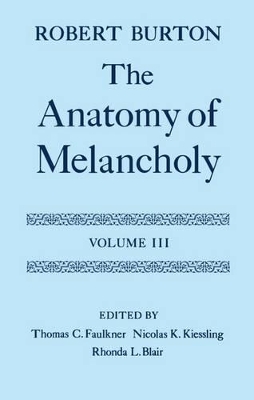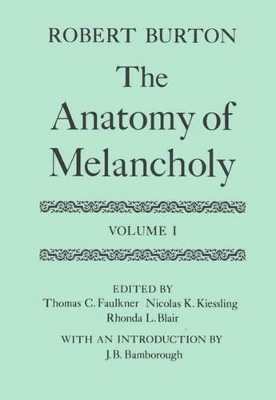Oxford English Texts
3 total works
This is the second volume of the Clarendon edition of Robert Burton's The Anatomy of Melancholy, containing the text and textual apparatus for `The Second Partition'. A third volume of text and two volumes of commentary will follow.
In `The Second Partition', Burton treats the spectrum of cures for melancholy, generally following the organization and analysis of symptoms and causes of the disorder as presented in `The First Partition'. Here is found Burton's remarkable synthesis of cultural geography and climatic influences on temperament in the `Digression of the Ayre' and his long excursion in the consolatio tradition. The final two sections of the partition present remedies from physics and surgery.
In `The Second Partition', Burton treats the spectrum of cures for melancholy, generally following the organization and analysis of symptoms and causes of the disorder as presented in `The First Partition'. Here is found Burton's remarkable synthesis of cultural geography and climatic influences on temperament in the `Digression of the Ayre' and his long excursion in the consolatio tradition. The final two sections of the partition present remedies from physics and surgery.
This is the third and final text volume of the Clarendon edition of Robert Burton's The Anatomy of Melancholy. It contains `The Third Partition', `The Table', edited from 1624-1651 editions, and their textual apparatus, and an Index of Persons. Also included are three appendices: `The Conclusion of the Author to the Reader', which occurs only in the 1621 edition, a list of stop-press corrections to the 1632 edition, and the edited Synoptic Tables.
The Third Partition is made up of two grand digressions which conclude Burton's earlier arguments on the causes and cures of melancholy. In the first digression he anatomizes love melancholy, its kinds, causes and symptom, and cures. No one up to his time had dealt more elaborately, or more thoroughly, with the components of love. Certain sections, `Beauty a Cause', of `Jealousie, his Æquivocations, Name, Definition, Extent ...' are no less engaging today than when they were first written.
In the second, religious melancholy, he surveys the aberrations from true religious commitment which are the cause of this melancholy. To Burton the divine, no other manifestation of melancholy was as serious as this, and his words of comfort, consolation, and encouragement, are a fitting end to his
dissection of a disease that all are heir to.
The Third Partition is made up of two grand digressions which conclude Burton's earlier arguments on the causes and cures of melancholy. In the first digression he anatomizes love melancholy, its kinds, causes and symptom, and cures. No one up to his time had dealt more elaborately, or more thoroughly, with the components of love. Certain sections, `Beauty a Cause', of `Jealousie, his Æquivocations, Name, Definition, Extent ...' are no less engaging today than when they were first written.
In the second, religious melancholy, he surveys the aberrations from true religious commitment which are the cause of this melancholy. To Burton the divine, no other manifestation of melancholy was as serious as this, and his words of comfort, consolation, and encouragement, are a fitting end to his
dissection of a disease that all are heir to.
Robert Burton's The Anatomy of Melancholy is one of the last great works of English prose to have remained unedited. The present volume inaugurates an authoritative edition of the work, which is being prepared by scholars on both sides of the Atlantic. It will be followed by two further volumes of text with textual apparatus, and two volumes of commentary.
Burton concentrated a lifetime of inquiry into the Anatomy, describing and analysing melancholy and its causes - devoting especial attention to love and religion - and recording possible cures. Primarily a scholarly study of morbid psychology, it is also a compendium of curious facts and anecdotes, and combines seriousness of purpose with a marked satirical vein.
First published in 1621, it was a great success: four more editions were published in Burton's lifetime, in each of which new material was added, and a sixth, containing his final revisions, was published in in 1651, eleven years after his death. The textual complexity and Burton's extraordinary range of reference have hitherto deterred editors: this is the first scholarly edition to appear. The text is based on a complete collation of all six authoritative editions.
Burton concentrated a lifetime of inquiry into the Anatomy, describing and analysing melancholy and its causes - devoting especial attention to love and religion - and recording possible cures. Primarily a scholarly study of morbid psychology, it is also a compendium of curious facts and anecdotes, and combines seriousness of purpose with a marked satirical vein.
First published in 1621, it was a great success: four more editions were published in Burton's lifetime, in each of which new material was added, and a sixth, containing his final revisions, was published in in 1651, eleven years after his death. The textual complexity and Burton's extraordinary range of reference have hitherto deterred editors: this is the first scholarly edition to appear. The text is based on a complete collation of all six authoritative editions.


